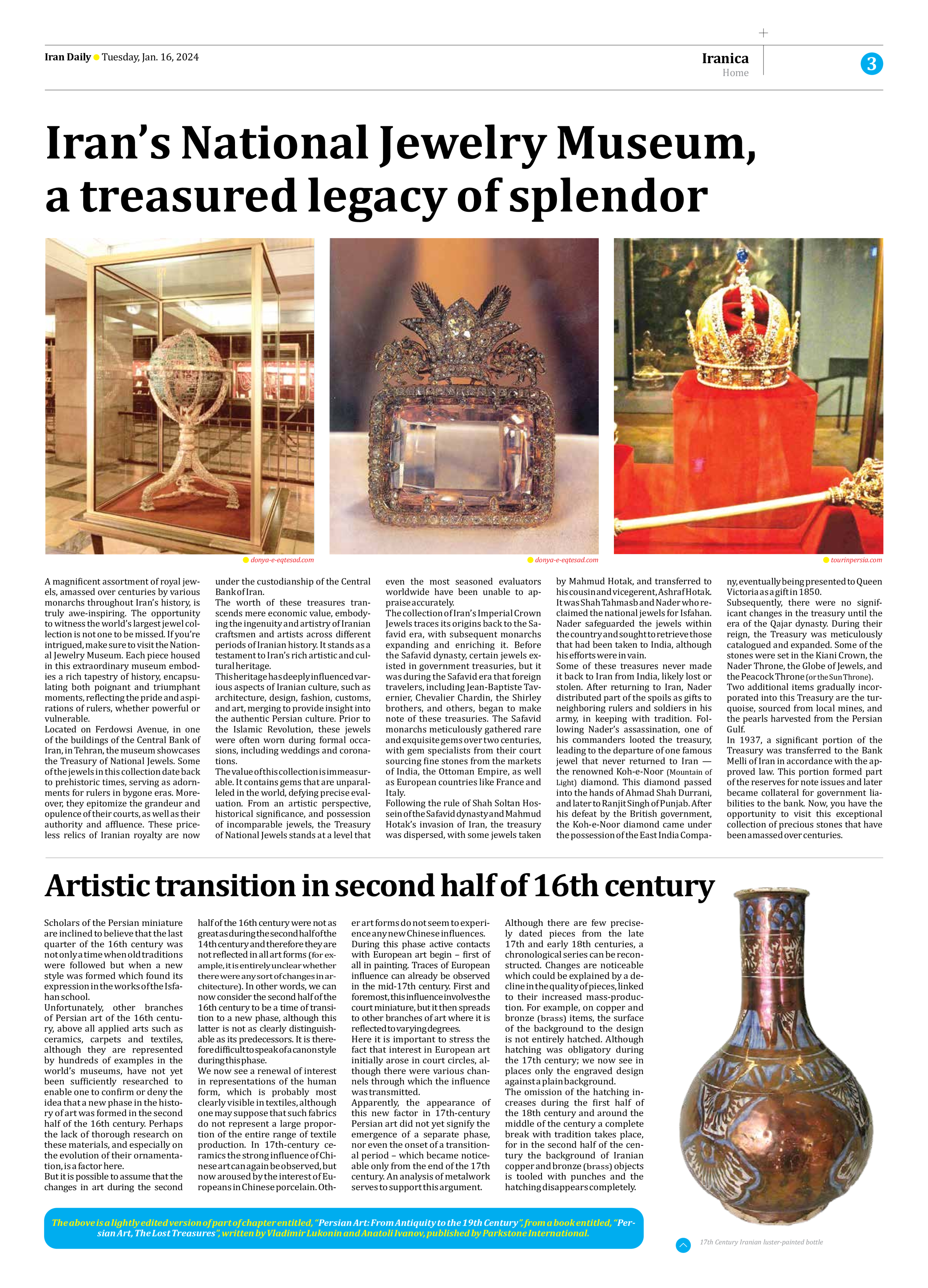
Iran’s National Jewelry Museum, a treasured legacy of splendor
A magnificent assortment of royal jewels, amassed over centuries by various monarchs throughout Iran’s history, is truly awe-inspiring. The opportunity to witness the world’s largest jewel collection is not one to be missed. If you’re intrigued, make sure to visit the National Jewelry Museum. Each piece housed in this extraordinary museum embodies a rich tapestry of history, encapsulating both poignant and triumphant moments, reflecting the pride and aspirations of rulers, whether powerful or vulnerable.
Located on Ferdowsi Avenue, in one of the buildings of the Central Bank of Iran, in Tehran, the museum showcases the Treasury of National Jewels. Some of the jewels in this collection date back to prehistoric times, serving as adornments for rulers in bygone eras. Moreover, they epitomize the grandeur and opulence of their courts, as well as their authority and affluence. These priceless relics of Iranian royalty are now under the custodianship of the Central Bank of Iran.
The worth of these treasures transcends mere economic value, embodying the ingenuity and artistry of Iranian craftsmen and artists across different periods of Iranian history. It stands as a testament to Iran’s rich artistic and cultural heritage.
This heritage has deeply influenced various aspects of Iranian culture, such as architecture, design, fashion, customs, and art, merging to provide insight into the authentic Persian culture. Prior to the Islamic Revolution, these jewels were often worn during formal occasions, including weddings and coronations.
The value of this collection is immeasurable. It contains gems that are unparalleled in the world, defying precise evaluation. From an artistic perspective, historical significance, and possession of incomparable jewels, the Treasury of National Jewels stands at a level that even the most seasoned evaluators worldwide have been unable to appraise accurately.
The collection of Iran’s Imperial Crown Jewels traces its origins back to the Safavid era, with subsequent monarchs expanding and enriching it. Before the Safavid dynasty, certain jewels existed in government treasuries, but it was during the Safavid era that foreign travelers, including Jean-Baptiste Tavernier, Chevalier Chardin, the Shirley brothers, and others, began to make note of these treasuries. The Safavid monarchs meticulously gathered rare and exquisite gems over two centuries, with gem specialists from their court sourcing fine stones from the markets of India, the Ottoman Empire, as well as European countries like France and Italy.
Following the rule of Shah Soltan Hossein of the Safavid dynasty and Mahmud Hotak’s invasion of Iran, the treasury was dispersed, with some jewels taken by Mahmud Hotak, and transferred to his cousin and vicegerent, Ashraf Hotak. It was Shah Tahmasb and Nader who reclaimed the national jewels for Isfahan. Nader safeguarded the jewels within the country and sought to retrieve those that had been taken to India, although his efforts were in vain.
Some of these treasures never made it back to Iran from India, likely lost or stolen. After returning to Iran, Nader distributed part of the spoils as gifts to neighboring rulers and soldiers in his army, in keeping with tradition. Following Nader’s assassination, one of his commanders looted the treasury, leading to the departure of one famous jewel that never returned to Iran — the renowned Koh-e-Noor (Mountain of Light) diamond. This diamond passed into the hands of Ahmad Shah Durrani, and later to Ranjit Singh of Punjab. After his defeat by the British government, the Koh-e-Noor diamond came under the possession of the East India Company, eventually being presented to Queen Victoria as a gift in 1850.
Subsequently, there were no significant changes in the treasury until the era of the Qajar dynasty. During their reign, the Treasury was meticulously catalogued and expanded. Some of the stones were set in the Kiani Crown, the Nader Throne, the Globe of Jewels, and the Peacock Throne (or the Sun Throne).
Two additional items gradually incorporated into this Treasury are the turquoise, sourced from local mines, and the pearls harvested from the Persian Gulf.
In 1937, a significant portion of the Treasury was transferred to the Bank Melli of Iran in accordance with the approved law. This portion formed part of the reserves for note issues and later became collateral for government liabilities to the bank. Now, you have the opportunity to visit this exceptional collection of precious stones that have been amassed over centuries.







